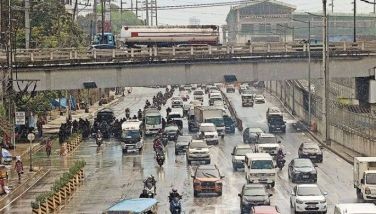Manila cops, videos tell different versions of drug killing
MANILA, Philippines — The police report was clear. Police drug officers shot and injured three men in a poor district of Manila, then “rushed” them to hospital where they were pronounced dead on arrival.
But security camera footage obtained by Reuters tells a different story of what happened just after midday on Oct. 11 in Barangay 19, Tondo district.
It shows that police took at least 25 minutes to haul away the men they had shot. The victims show no signs of life; police are seen carrying them by their arms and legs and loading their limp bodies onto pedicabs to take them to hospital.
A witness to the Barangay 19 killings said the three men were executed and not, as the police claimed, shot in self-defense. Police said they only use deadly force in self-defense, but a series of investigations by Reuters suggest they are summarily executing people.
The security camera footage not only contradicts the police account of the Barangay 19 killings. It also provides further evidence of another drug-war tactic: the disabling of surveillance cameras at crime scenes by the police. In the footage, filmed simultaneously by four security cameras, an officer is seen turning the camera that captured the action away from the scene.
The police understand the dangers posed by such footage, which can expose their actions. An active-duty commander involved in the drug war told Reuters earlier this year that police collude with local officials to unplug security cameras in areas where they plan to carry out a drug-war killing.
Reuters has obtained footage from all four security cameras, each capturing the episode from a different angle. Together, the cameras provide a unique record of a police operation from start to finish. Some of the Barangay 19 footage was previously aired by GMA-7.
Just following orders
“The operation was legitimate,” Manila Police District Station 2 commander Supt. Santiago Pascual said.
A station investigation showed that his officers had followed correct operational procedure, according to Pascual.
He said the eyewitness testimony that they had opened fire on unarmed men was “untrue and unfounded.”
The slain suspects were identified as Rolando Campo, Sherwin Bitas and Ronnie Cerbito.
Six of the policemen involved in the incident were identified as Chief Insps. Michael Garcia and Anthony Sy; PO3s Ferdinand Concon, Rex Muñoz and Gener Paguyo, and PO2 Ronel Siriban, all assigned to the MPD Station 2.
The report said Campo, 60, sold drugs to an undercover officer, who signaled for backup. Campo “sensed the presence” of the police officers and ordered his two associates Bitas and Cerbito to draw their guns and open fire on them, the report said.
The police retaliated, leaving the three men “fatally wounded,” it said.
But the footage shows Campo chatting with people in the neighborhood in the minutes before the police arrive and not, as the report said, selling drugs to an undercover police officer.
The police operation doesn’t seem to be undercover.
In the security video, one of the policemen was in uniform, five were wearing vests or body armor, and another wearing a mask.
One of the operatives was also seen turning the security camera to another direction.
The footage showed them entering the area through the alley on which Campo and Bitas lived at the corner of Sta. Barbara and Kagitingan streets.
The policemen passed in full view of the victims’ house seven minutes before the shooting started.
Arlene Gibaga, Bitas’ wife, claimed she witnessed the shooting and the three men were unarmed.
“We don’t have the money for guns,” Gibaga said.
She said her husband didn’t deal drugs.
Police detained the men in an alley next to her house, she said, and asked her to get Bitas’ ID. When she produced it, said Gibaga, one officer shouted “Positive! Positive!” and then the officers fired on Bitas.
“Don’t do that to my husband!” she screamed, as the police shot Bitas. “I will report you! There are CCTV cameras here!”
One of the officers then aimed his gun at Gibaga and ordered her inside, she said.
The footage doesn’t show the police shooting the three men, but does show an officer appearing to open fire at an unseen target. Campo then falls backwards into the frame, his body hitting the ground. His arms move for a while before resting motionless.
Less than a minute later, the camera that captured the scene of the shooting is effectively put out of action: someone turns it to face the wall. A second camera shows a police officer reaching up and turning it away.
Pascual said they are ready to face any investigation on the allegations of summary execution of the suspects.
“We will face the investigations, if there are any, in a proper forum,” Pascual said.
Pascual admitted the security camera was averted for a “valid security reason” and to ensure the operation wasn’t compromised. His statement reiterated the police report’s version of events – “that the suspects first drew firearms and shot the operatives,” who returned fire in self-defense.
Later that day, at the MPD Station 2, Gibaga said the officers told her it was useless to complain.
“It’s the government you will be fighting against,” she recalled one police officer saying.
“Don’t get angry at us. We are just following orders.”
Philippine National Police (PNP) chief Director General Ronald dela Rosa promised there would be no coverup in the investigation over the incident.
Dela Rosa said he has not seen the video. He questioned Reuters’ motives for releasing the article on the eve of oral arguments before the Supreme Court on petitions questioning the legality of the government’s anti-drug campaign.
He also wondered why the news article was made public after President Duterte announced he might bring the PNP back to the war on illegal drugs.
It means only one thing, Dela Rosa said, and that is their critics are doing everything to prevent them from returning to the drug war.
“What are they afraid of? They don’t seem to be drug addicts,” he said.
New doubts
The footage in Tondo casts new doubts on the official accounts of police killings in President Duterte’s 17-month war on drugs.
In June, Reuters revealed that police have shot hundreds of people during anti-drug operations, then taken them to hospitals where they are declared dead on arrival.
Police said they’re trying to save lives. Bereaved relatives and other witnesses allege police are sending corpses to hospitals to disrupt crime scenes and cover up extrajudicial killings.
Police have shot dead at least 3,900 people in anti-narcotic operations since Duterte took power in June 2016 – always in self-defense, police say. Human rights activists blame police for thousands more killings attributed to vigilantes, but authorities deny any involvement.
Police carried out the Oct. 11 raid a day after Duterte ordered them to leave anti-drug operations to the Philippine Drug Enforcement Agency (PDEA).
Asked why the Manila police still conducted an anti-drug operation when Duterte already directed the PNP to cease operations, Dela Rosa answered not all policemen are watching television.
“Our troops on the ground are busy,” Dela Rosa said. He added Duterte’s directive was not immediately relayed officially.
The October memo marked the second time that Duterte has publicly told police officers to stop waging his drug war.
Duterte announced a halt to their operations in late January after news emerged that police had kidnapped and murdered a South Korean businessman.
He lifted the ban one month later, saying drugs were returning to the streets.
In his latest order, Duterte said he wanted “to bring order to the operation/campaign against illegal drugs, thus pinpointing precise accountability.”
The announcement came amid escalating public criticism of alleged police atrocities. Recent surveys have shown rising distrust of the police and unease with their brutal methods, which have been criticized by the Catholic Church.
The circulation online of security camera footage of police operations and vigilante killings has spurred public disquiet with Duterte’s bloody anti-drug campaign. Outrage followed the August release of video that seemed to back up eyewitness accounts of how teenager Kian Loyd delos Santos was killed that month.
Police said they shot the 17-year-old in self-defense after he opened fire. Eyewitnesses said police took the unarmed boy to a trash-filled alley in Caloocan City and shot him in the head. Footage emerged showing two officers marching a figure toward the spot where Delos Santos’ body was found. His funeral procession turned into the biggest protest yet against the drug war. – Rey Galupo, Emmanuel Tupas, Reuters
- Latest
- Trending




























